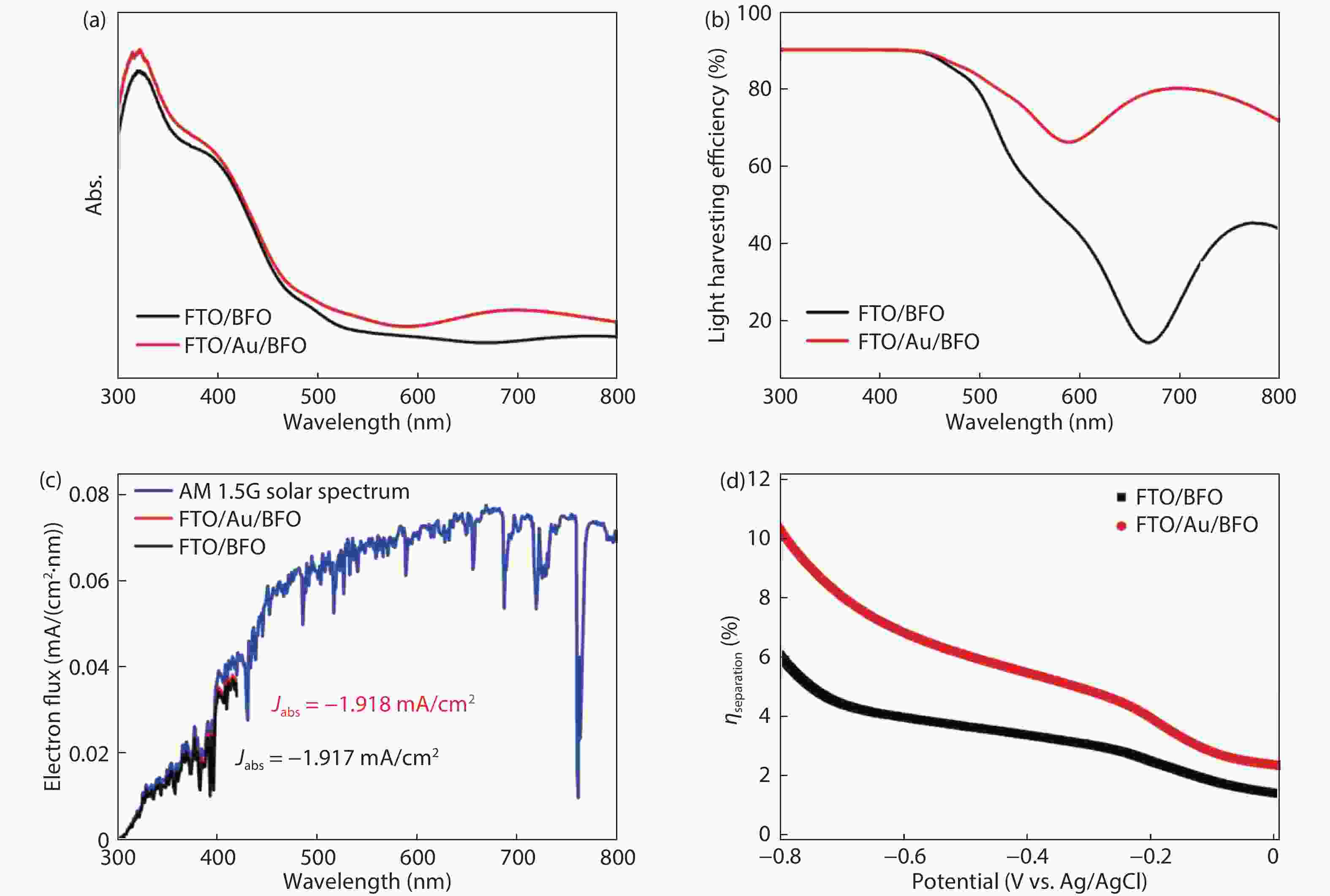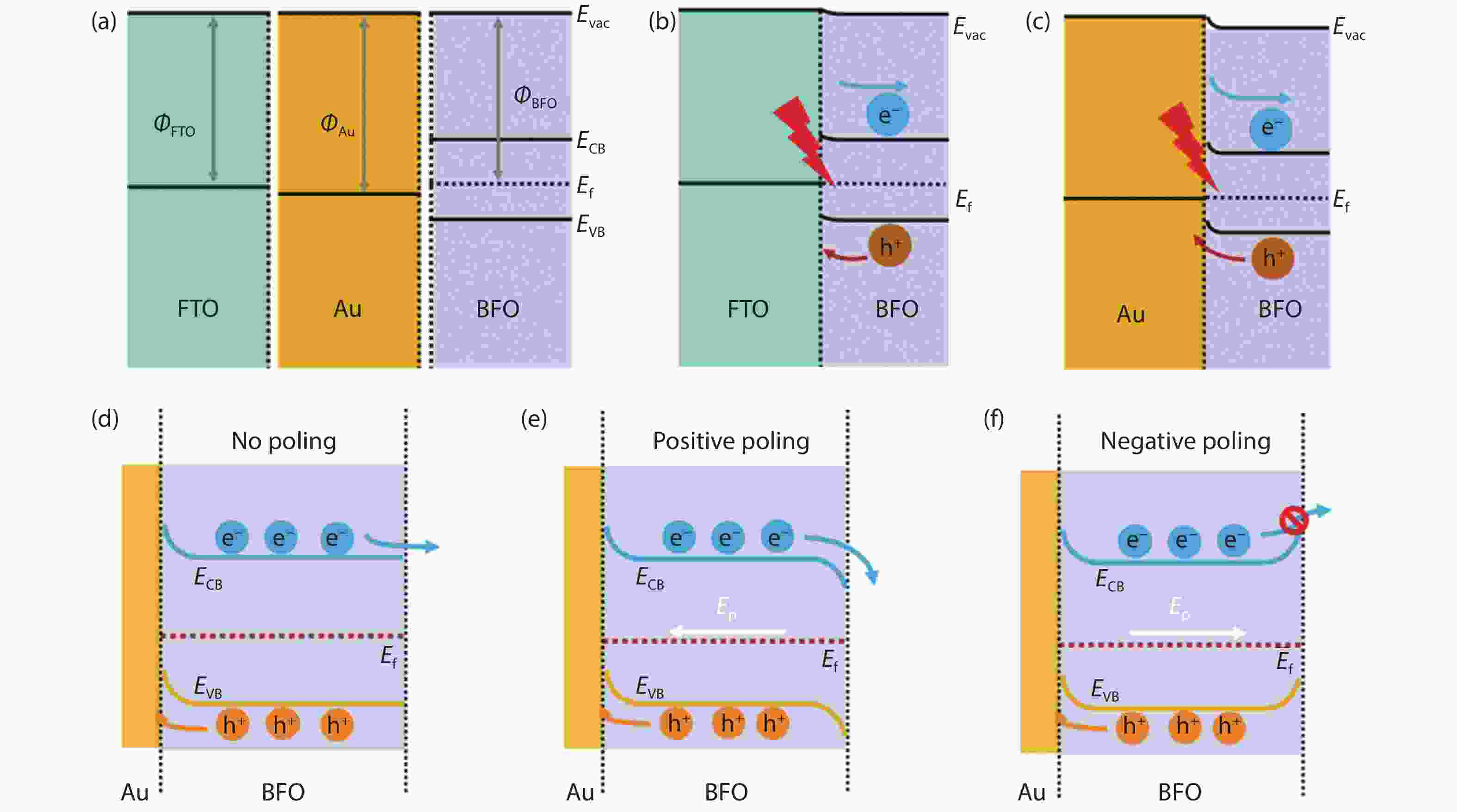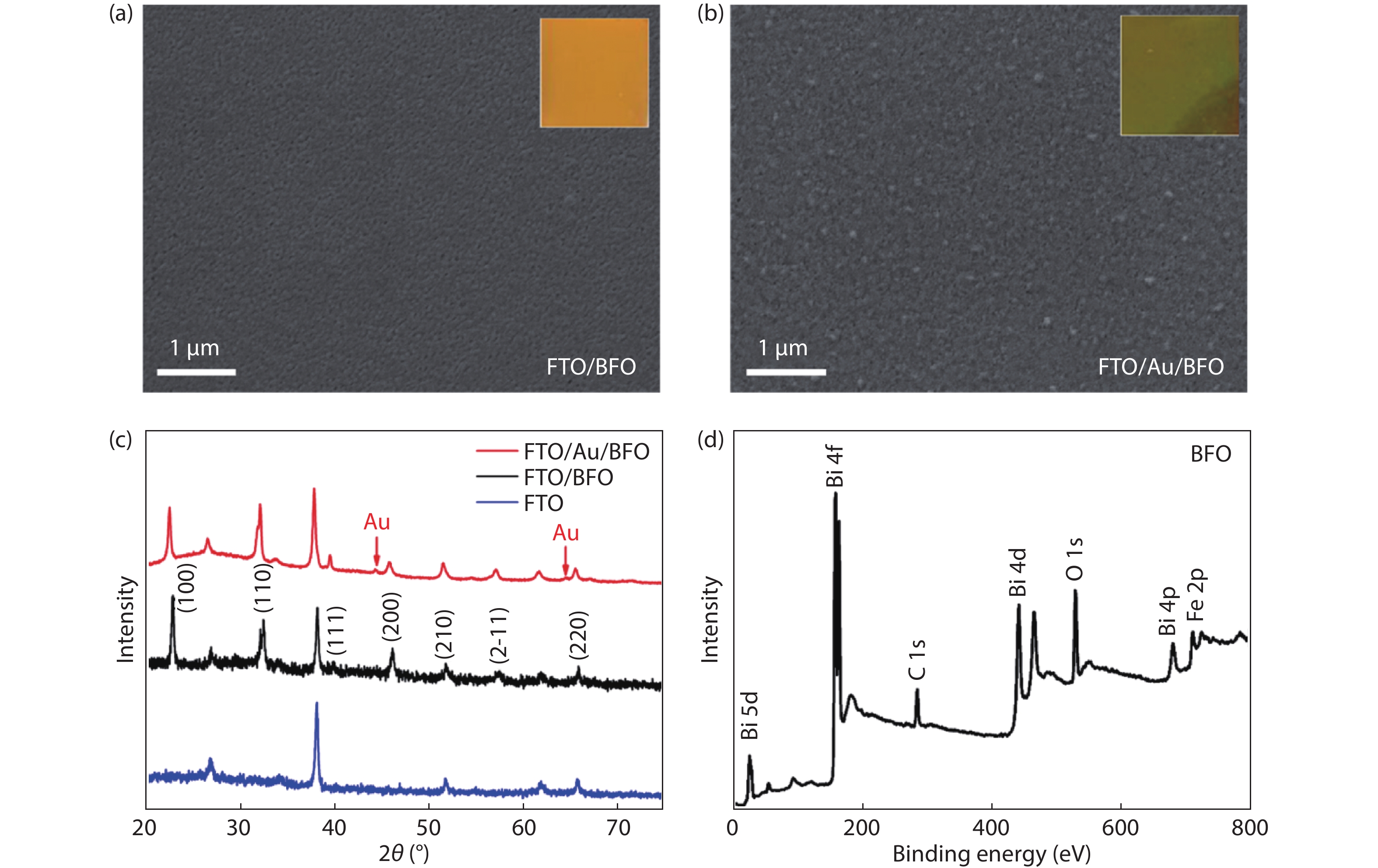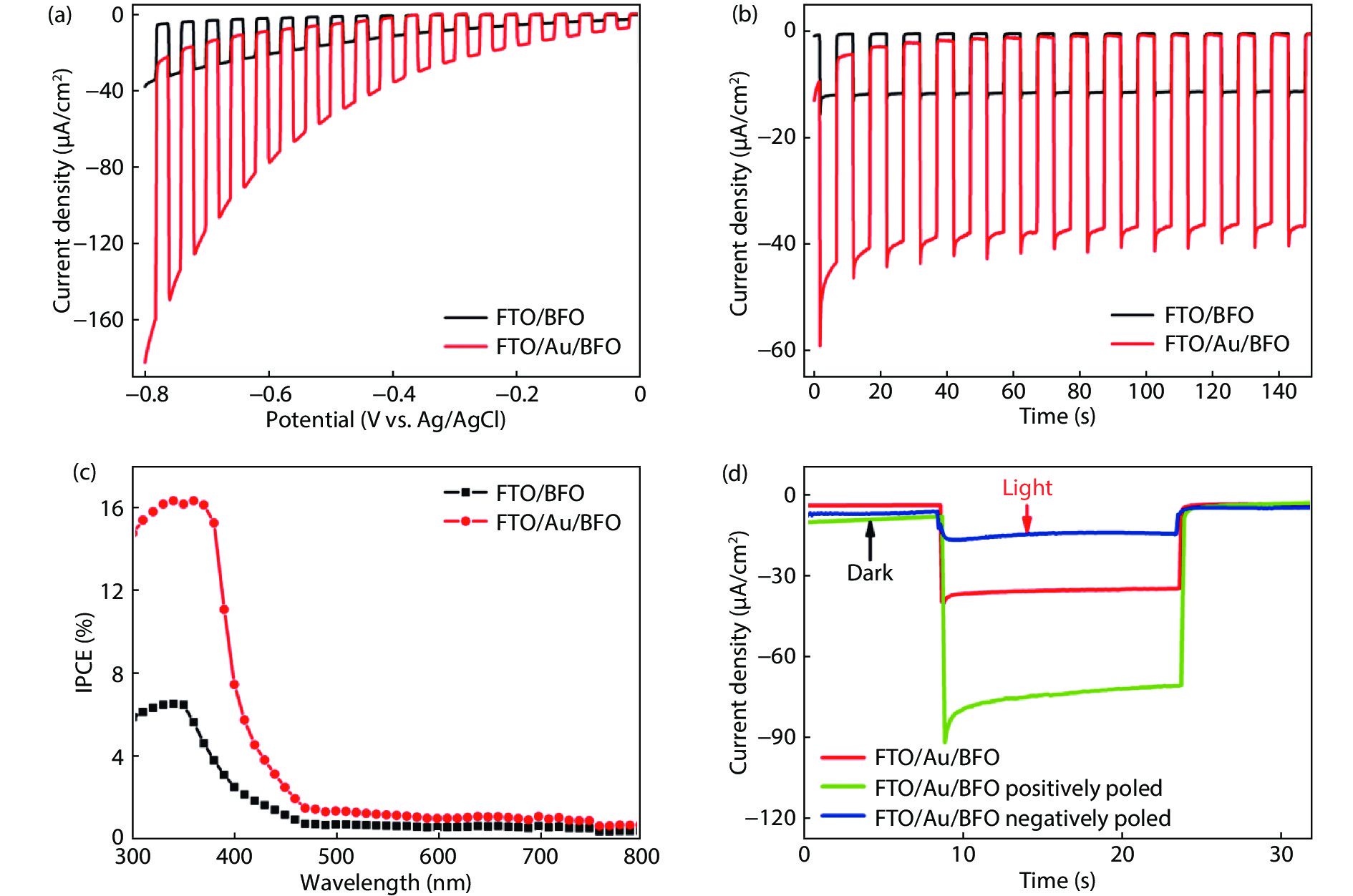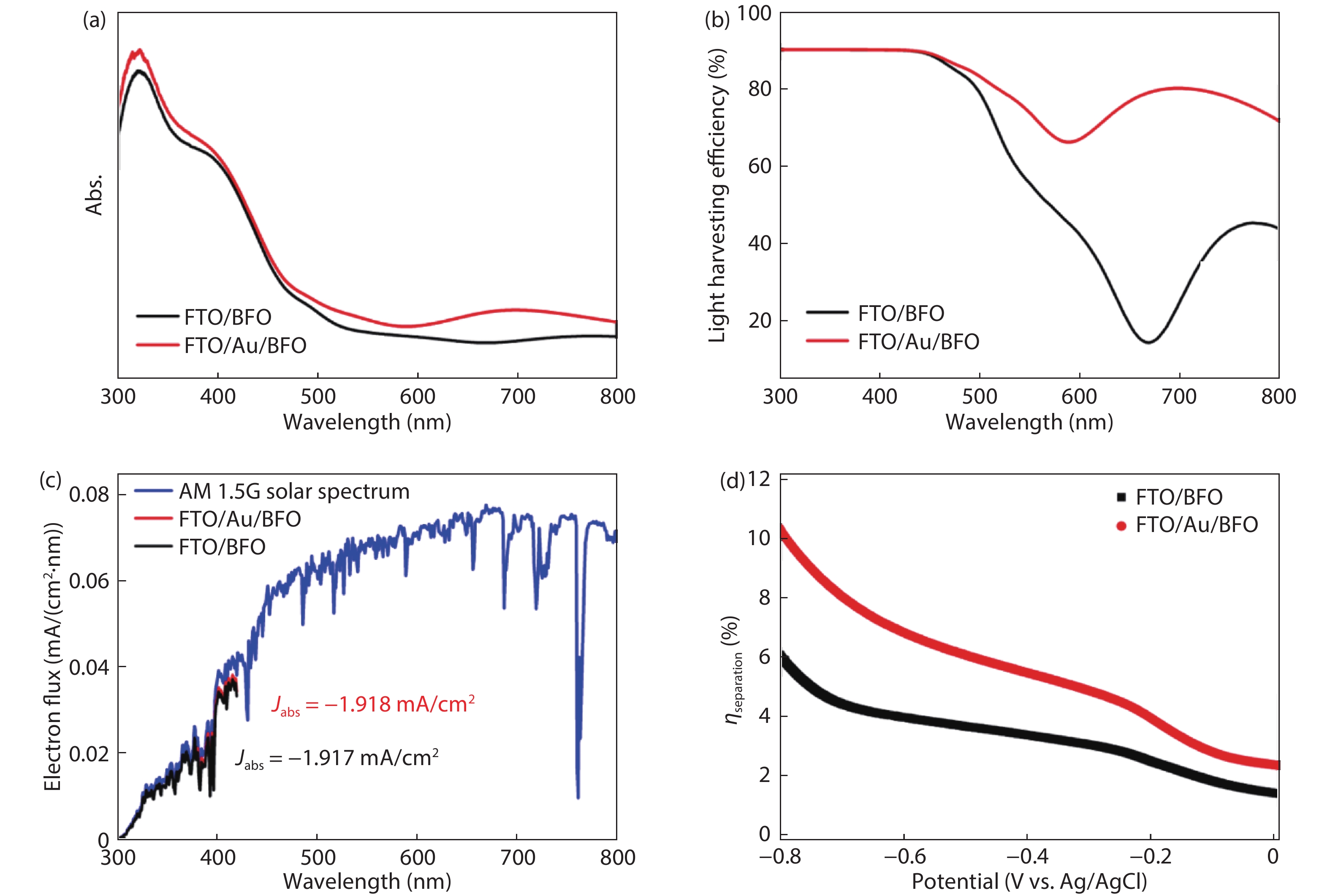| Citation: |
Dawei Cao, Ming Li, Jianfei Zhu, Yanfang He, Tong Chen, Yuan Liu, Mingming Chen, Ying Yang. Enhancement of photoelectrochemical performance in ferroelectric films via the introduction of an Au buffer layer[J]. Journal of Semiconductors, 2021, 42(11): 112701. doi: 10.1088/1674-4926/42/11/112701
D W Cao, M Li, J F Zhu, Y F He, T Chen, Y Liu, M M Chen, Y Yang, Enhancement of photoelectrochemical performance in ferroelectric films via the introduction of an Au buffer layer[J]. J. Semicond., 2021, 42(11): 112701. doi: 10.1088/1674-4926/42/11/112701.
Export: BibTex EndNote
|
Enhancement of photoelectrochemical performance in ferroelectric films via the introduction of an Au buffer layer
doi: 10.1088/1674-4926/42/11/112701
More Information-
Abstract
The inefficient separation of photogenerated carriers has become a serious problem that limits the photoelectrochemical (PEC) performance of semiconductors. Herein, a sol-gel method was used to prepare BiFeO3 ferroelectric thin films with FTO and FTO/Au as substrates, respectively. The polarization electric field of the ferroelectric can more effectively separate the carriers generated in the photoelectrode. Meanwhile, the introduction of an Au buffer layer can reduce the resistance in the process of charge transfer, accelerate the carrier migration, and enhance the efficiency of the charge separation. Under light irradiation, Au/BiFeO3 photoelectrode exhibited an extraordinary improvement in PEC water splitting compared with BiFeO3. In addition, the ferroelectric polarization electric field causes band bending, which further accelerates the separation of electrons and holes and improves the PEC performance of the photoelectrode. This work promotes the effective application of ferroelectric films in PEC water splitting.-
Keywords:
- photoelectrochemical,
- BiFeO3,
- ferroelectric films,
- charge separation
-
References
[1] Zhao H, Lei Y. 3D nanostructures for the next generation of high-performance nanodevices for electrochemical energy conversion and storage. Adv Energy Mater, 2020, 10(28), 2001460 doi: 10.1002/aenm.202001460[2] Wang P, Li G, Wang M, et al. Numerical study of mono-crystalline silicon solar cells with passivated emitter and rear contact configuration for the efficiency beyond 24% based on mass production technology. J Semicond, 2020, 41(6), 062701 doi: 10.1088/1674-4926/41/6/062701[3] Wang S, Wang Y, Zhang S L, et al. Supporting ultrathin ZnIn2S4 nanosheets on Co/N-doped graphitic carbon nanocages for efficient photocatalytic H2 generation. Adv Mater, 2019, 31(41), 1903404 doi: 10.1002/adma.201903404[4] Nasori N, Dai T, Jia X, et al. Realizing super-long Cu2O nanowires arrays for high-efficient water splitting applications with a convenient approach. J Semicond, 2019, 40(5), 052701 doi: 10.1088/1674-4926/40/5/052701[5] Zhu H, Sha M, Zhao H, et al. Highly-rough surface carbon nanofibers film as an effective interlayer for lithium-sulfur batteries. J Semicond, 2020, 41(9), 092701 doi: 10.1088/1674-4926/41/9/092701[6] Berglund S P, Abdi F F, Bogdanoff P, et al. Comprehensive evaluation of CuBi2O4 as a photocathode material for photoelectrochemical water splitting. Chem Mater, 2016, 28(12), 4231 doi: 10.1021/acs.chemmater.6b00830[7] Feng S, Wang T, Liu B, et al. Enriched surface oxygen vacancies of photoanodes by photoetching with enhanced charge separation. Angew Chem Int Ed, 2020, 59(5), 2044 doi: 10.1002/anie.201913295[8] Ma M, Huang Y, Liu J, et al. Engineering the photoelectrochemical behaviors of ZnO for efficient solar water splitting. J Semicond, 2020, 41(9), 091702 doi: 10.1088/1674-4926/41/9/091702[9] Guo X, Liu Q, Tian H, et al. Optimization of broadband omnidirectional antireflection coatings for solar cells. J Semicond, 2019, 40(3), 032702 doi: 10.1088/1674-4926/40/3/032702[10] Deng Y, Liu J, Huang Y, et al. Engineering the photocatalytic behaviors of g/C3N4-based metal-free materials for degradation of a representative antibiotic. Adv Funct Mater, 2020, 30(31), 2002353 doi: 10.1002/adfm.202002353[11] Liu J, Wang Z, Lei Y. A close step towards industrialized application of solar water splitting. J Semicond, 2020, 41(9), 090401 doi: 10.1088/1674-4926/41/9/090401[12] Yang L, Loh L, Nandakumar D K, et al. Sustainable fuel production from ambient moisture via ferroelectrically driven MoS2 nanosheets. Adv Mater, 2020, 32(25), 2000971 doi: 10.1002/adma.202000971[13] Huang Y, Liu J, Deng Y, et al. The application of perovskite materials in solar water splitting. J Semicond, 2020, 41(1), 011701 doi: 10.1088/1674-4926/41/1/011701[14] Cao D, Wang C, Zheng F, et al. High-efficiency ferroelectric-film solar cells with an n-type Cu2O cathode buffer layer. Nano Lett, 2012, 12(6), 2803 doi: 10.1021/nl300009z[15] Li S, Bai L, Ji N, et al. Ferroelectric polarization and thin-layered structure synergistically promoting CO2 photoreduction of Bi2MoO6. J Mater Chem A, 2020, 8(18), 9268 doi: 10.1039/D0TA02102D[16] Bhatnagar A, Roy Chaudhuri A, Heon Kim Y, et al. Role of domain walls in the abnormal photovoltaic effect in BiFeO3. Nat Commun, 2013, 4(1), 2835 doi: 10.1038/ncomms3835[17] Zhao C, Wang Z, Shu D, et al. Preface to the special issue on challenges and possibilities of energy storage. J Semicond, 2020, 41(9), 090101 doi: 10.1088/1674-4926/41/9/090101[18] Yang S Y, Seidel J, Byrnes S J, et al. Above-bandgap voltages from ferroelectric photovoltaic devices. Nat Nanotechnol, 2010, 5(2), 143 doi: 10.1038/nnano.2009.451[19] Wang S, Nan F, Zhou Y, et al. Enhanced photoelectrochemical performance in BiFeO3/g-C3N4 p-n heterojunction photocathodes with ferroelectric polarization. J Appl Phys, 2020, 128(15), 154101 doi: 10.1063/5.0018856[20] Khoomortezaei S, Abdizadeh H, Golobostanfard M R. Triple layer heterojunction WO3/BiVO4/BiFeO3 porous photoanode for efficient photoelectrochemical water splitting. ACS Appl Energ Mater, 2019, 2(9), 6428 doi: 10.1021/acsaem.9b01041[21] Huang J, Wang Y, Liu X, et al. Synergistically enhanced charge separation in BiFeO3/Sn:TiO2 nanorod photoanode via bulk and surface dual modifications. Nano Energy, 2019, 59, 33 doi: 10.1016/j.nanoen.2019.02.025[22] Sheikh M S, Ghosh D, Bhowmik T K, et al. When multiferroics become photoelectrochemical catalysts: A case study with BiFeO3/La2NiMnO6. Mater Chem Phys, 2020, 244, 122685 doi: 10.1016/j.matchemphys.2020.122685[23] Zhu J, He Y, Yang Y, et al. BiFeO3/Cu2O heterojunction for efficient photoelectrochemical water splitting under visible-light irradiation. Catal Lett, 2021, 151, 382 doi: 10.1007/s10562-020-03338-1[24] Liu Y, Ye S, Xie H, et al. Internal-field-enhanced charge separation in a single-domain ferroelectric PbTiO3 photocatalyst. Adv Mater, 2020, 32(7), 1906513 doi: 10.1002/adma.201906513[25] Wang P, He Y, Mi Y, et al. Enhanced photoelectrochemical performance of LaFeO3 photocathode with Au buffer layer. RSC Adv, 2019, 9(46), 26780 doi: 10.1039/C9RA05521E[26] Cao D, Nasori N, Wang Z, et al. P-type CuBi2O4: An easily accessible photocathodic material for high-efficiency water splitting. J Mater Chem A, 2016, 4(23), 8995 doi: 10.1039/C6TA01234E[27] Bera S, Ghosh S, Shyamal S, et al. Photocatalytic hydrogen generation using gold decorated BiFeO3 heterostructures as an efficient catalyst under visible light irradiation. Sol Energ Mat Sol C, 2019, 194, 195 doi: 10.1016/j.solmat.2019.01.042[28] Ma Y, Lv P, Duan F, et al. Direct Z-scheme Bi2S3/BiFeO3 heterojunction nanofibers with enhanced photocatalytic activity. J Alloy Compd, 2020, 834, 155158 doi: 10.1016/j.jallcom.2020.155158[29] Ge L, Xu Y, Ding L, et al. Perovskite-type BiFeO3/ultrathin graphite-like carbon nitride nanosheets p-n heterojunction: Boosted visible-light-driven photoelectrochemical activity for fabricating ampicillin aptasensor. Biosens Bioelectron, 2019, 124, 33 doi: 10.1016/j.bios.2018.09.093[30] Yang W, Yu Y, Starr M B, et al. Ferroelectric polarization-enhanced photoelectrochemical water splitting in TiO2-BaTiO3 core-shell nanowire photoanodes. Nano Lett, 2015, 15(11), 7574 doi: 10.1021/acs.nanolett.5b03988[31] He Y, Shen P, Liu Y, et al. Integrated heterostructure of PZT/CdS containing the synergistic effect between heterojunction structure and ferroelectric polarization for photoelectrochemical applications. Mat Sci Semicon Proc, 2021, 121, 105351 doi: 10.1016/j.mssp.2020.105351[32] Yang B, Wu C, Wang J, et al. When C3N4 meets BaTiO3: Ferroelectric polarization plays a critical role in building a better photocatalyst. Ceram Int, 2020, 46(4), 4248 doi: 10.1016/j.ceramint.2019.10.145[33] Zhang X, Wang X, Chai J, et al. Construction of novel symmetric double Z-scheme BiFeO3/CuBi2O4/BaTiO3 photocatalyst with enhanced solar-light-driven photocatalytic performance for degradation of norfloxacin. Appl Catal B, 2020, 272, 119017 doi: 10.1016/j.apcatb.2020.119017[34] Luo W, Chen X, Wei Z, et al. Three-dimensional network structure assembled by g-C3N4 nanorods for improving visible-light photocatalytic performance. Appl Catal B, 2019, 255, 117761 doi: 10.1016/j.apcatb.2019.117761[35] Zhao W, Zhang Q, Wang H, et al. Enhanced catalytic performance of Ag2O/BaTiO3 heterostructure microspheres by the piezo/pyro-phototronic synergistic effect. Nano Energy, 2020, 73, 104783 doi: 10.1016/j.nanoen.2020.104783[36] Jiang W, Zong X, An L, et al. Consciously constructing heterojunction or direct Z-scheme photocatalysts by regulating electron flow direction. ACS Catal, 2018, 8(3), 2209 doi: 10.1021/acscatal.7b04323[37] He Y, Wang P, Zhu J, et al. Synergistical dual strategies based on in situ-converted heterojunction and reduction-induced surface oxygen vacancy for enhanced photoelectrochemical performance of TiO2. ACS Appl Mater Inter, 2019, 11(40), 37322 doi: 10.1021/acsami.9b12537[38] Shen H, Zhou X, Dong W, et al. Dual role of TiO2 buffer layer in Pt catalyzed BiFeO3 photocathodes: Efficiency enhancement and surface protection. Appl Phys Lett, 2017, 111(12), 123901 doi: 10.1063/1.4999969 -
Supplements
 2021-112701-suppl.pdf
2021-112701-suppl.pdf

-
Proportional views





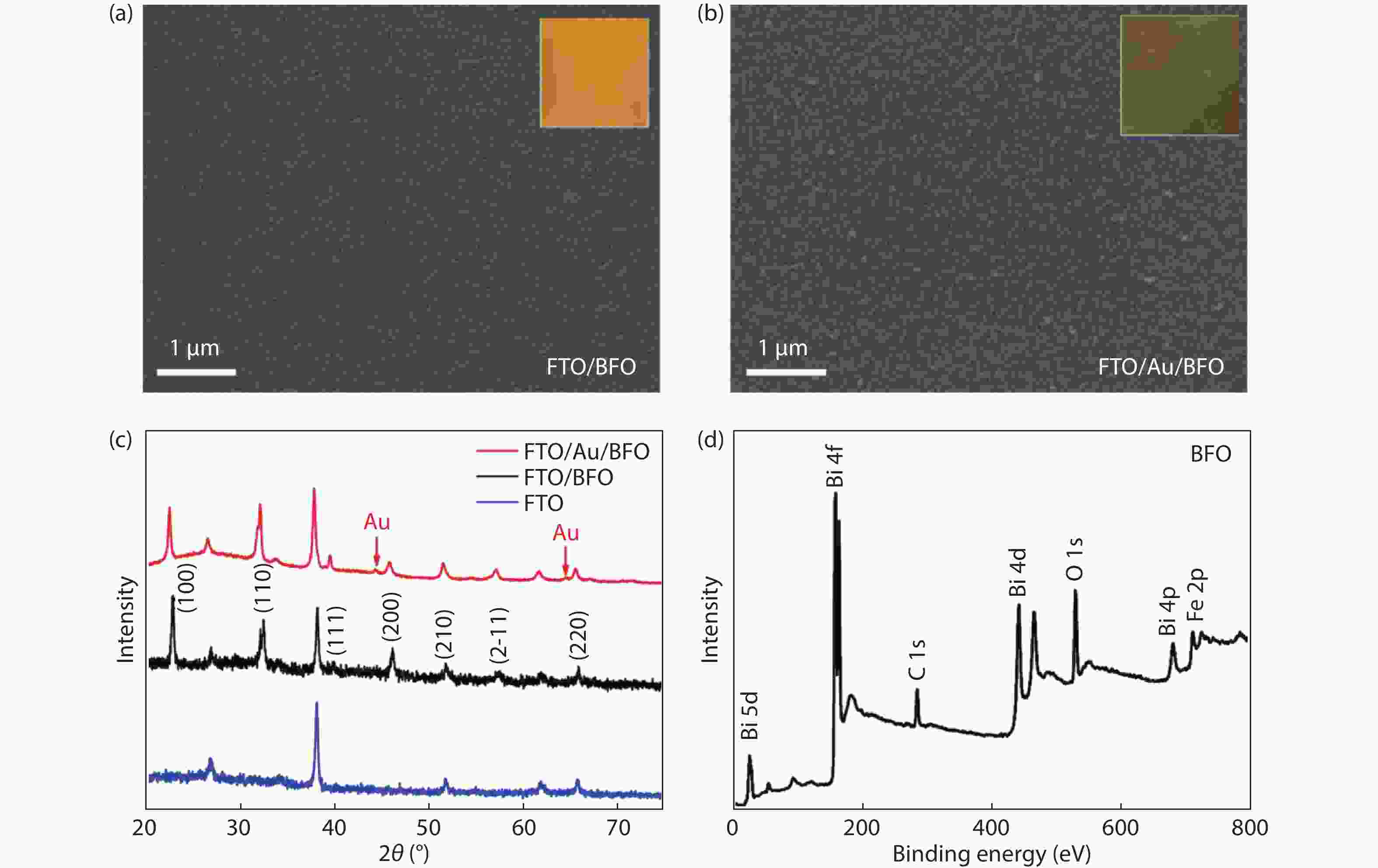
 DownLoad:
DownLoad:

